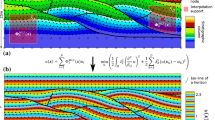Abstract
Discrete implicit modeling consists in representing structural surfaces as isovalues of three-dimensional piecewise linear scalar fields, which are interpolated from available data points. Data are expressed as local constraints that can enforce the value of the scalar fields as well as their gradients. This paper illustrates some limitations of published discrete implicit methods, related to the difficulty of controlling the norm of scalar field gradient and its evolution over the interpolated domain. It is shown that important artifacts may arise due to the intrinsic dependence between variations in the norm and the direction of the scalar field gradient, from one element to its neighbors. Evidence that these artifacts are related to mesh facet direction with respect to gradient direction are given. The artifacts lead to rapid and uncontrolled variations of thickness that may induce erroneous interpolations. This paper proposes two original approaches to overcome these problems. The first one consists in iteratively adjusting the norm of scalar field gradients in the direction obtained after previous iterations. The second solution consists in optimizing the mesh used by the interpolation. This requires finding appropriate mesh facet orientation with respect to scalar field gradient. These methods demonstrate that the results of discrete implicit surface interpolation can be improved and call for further development of available interpolation schemes.













Similar content being viewed by others
References
Calcagno P, Chilès JP, Courrioux G, Guillen A (2008) Geological modelling from field data and geological knowledge. Part I. Modelling method coupling 3D potential-field interpolation and geological rules. Phys Earth Planet Int 171:147–157
Caumon G (2010) Towards stochastic time-varying geological modeling. Math Geosci 42(5):555–569
Caumon G, Gray GG, Antoine C, Titeux M-O (2013) 3D implicit stratigraphic model building from remote sensing data on tetrahedral meshes: theory and application to a regional model of La Popa Basin, NE Mexico. IEEE Trans Geosci Remote Sens 51(3):1613–1621
Cherpeau N, Caumon G, Caers JK, Lévy B (2012) Method for stochastic inverse modeling of fault geometry and connectivity using flow data. Math Geosci 44(2):147–168
Chilès J-P, Aug C, Guillen A, Lees T (2004) Modelling the geometry of geological units and its uncertainty in 3D from structural data: the potential-field method. In: Proc. Int. Symp. Orebody Model. Strateg. Mine Plan, Perth, Australia, pp 313–320
Collon-Drouaillet P, Steckiewicz-Laurent W, Pellerin J, Laurent G, Caumon G, Reichart G, Vaute L (2015) 3D geomodelling combining implicit surfaces and Voronoi-based remeshing: a case study in the Lorraine Coal Basin (France). Comput Geosci 77:29–43
Cowan EJ, Beatson RK, Ross HJ, Fright WR, McLennan TJ, Evans TR, Carr JC, Lane RG, Bright DV, Gillman AJ, Oshust PA, Titley M (2003) Practical implicit geological modelling. In: Fifth Int. Min. Geol. Conf., pp 17–19
Frank T, Tertois AL, Mallet JL (2007) 3D-reconstruction of complex geological interfaces from irregularly distributed and noisy point data. Comput Geosci 33(7):932–943
Hillier MJ, Schetselaar EM, de Kemp EA, Perron G (2014) Three-dimensional modelling of geological surfaces using generalized interpolation with radial basis functions. Math. Geosci., pp 931–953. http://link.springer.com/10.1007/s11004-014-9540-3
Hjelle OY, Petersen SA, Bruaset AM (2013) A numerical framework for modeling folds in structural geology. Math Geosci 45(3):255–276
Jessell M, Aillères L, de Kemp E, Lindsay M, Wellmann F, Hillier M, Laurent G, Carmichael T, Martin R (2014) Next generation three-dimensional geologic modeling and inversion. Special Publ, SEG 18
Lajaunie C, Courrioux G, Manuel L (1997) Foliation fields and 3D cartography in geology: principles of a method based on potential interpolation. Math Geol 29(4):571–584
Laurent G, Caumon G, Bouziat A, Jessell M (2013) A parametric method to model 3D displacements around faults with volumetric vector fields. Tectonophys 590:83–93
Laurent G, Aillères L, Caumon G, Grose L (2014) Folding and poly-deformation modelling in implicit modelling approach. In: 34th Gocad Meet. Proc., pp 1–18
Mallet J-L (2014) Elements of mathematical sedimentary geology: the Geochron model. In: EAGE Publ
Mallet J-L, Tertois A-L (2010) Solid earth modeling and geometric uncertainties. In: SPE Annu. Tech. Conf. Exhib. Society of Petroleum Engineers
Mallet J-L (2004) Space-time mathematical framework for sedimentary geology. Math Geol 36(1):1–32
Massiot C, Caumon G (2010) Accounting for axial directions, cleavages and folding style during 3D structural modeling. In: 30th Gocad Meet. Proc
Maxelon M, Renard P, Courrioux G, Brändli M, Mancktelow N (2009) A workflow to facilitate three-dimensional geometrical modelling of complex poly-deformed geological units. Comput Geosci 35(3):644–658
Moyen R, Mallet J-L, Frank T, Leflon B, Royer J-J (2004) 3D-parameterization of the 3D geological space—the GeoChron model. In: Proc. ECMOR IX
Schurbet GL, Lewis TO, Boullion TL (1974) Quadratic matrix equations. Ohio J Sci 74(5):273–277
Souche L, Lepage F, Iskenova G (2013) Volume based modeling-automated construction of complex structural models. In: 75th EAGE Conf. Exhib. Inc. SPE EUROPEC
Acknowledgments
The author would like to gratefully thank anonymous reviewers, as well as Professor Guillaume Caumon and Lachlan Grose, for their very constructive comments and corrections, which helped improve this paper. This work was initiated at Monash University with the Australian Research Council Discovery Grant DP110102531 and further developed at GeoRessources (http://ring.georessources.univ-lorraine.fr/) in the framework of the “Investissements d’avenir” Labex RESSOURCES21 (ANR-10-LABX-21).
Author information
Authors and Affiliations
Corresponding author
Rights and permissions
About this article
Cite this article
Laurent, G. Iterative Thickness Regularization of Stratigraphic Layers in Discrete Implicit Modeling. Math Geosci 48, 811–833 (2016). https://doi.org/10.1007/s11004-016-9637-y
Received:
Accepted:
Published:
Issue Date:
DOI: https://doi.org/10.1007/s11004-016-9637-y




